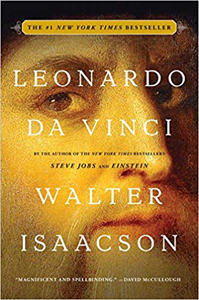 Walter Isaacson, Leonardo da Vinci (New York: Simon and Schuster, 2017), 624 pp.
Walter Isaacson, Leonardo da Vinci (New York: Simon and Schuster, 2017), 624 pp.
Book review by Brad Keister
In his most recent biography, Walter Isaacson moves further back in time from his chronicles of Einstein and Steve Jobs, to Leonardo da Vinci, who has epitomized the Renaissance more than any other individual.
Leonardo was born the illegitimate son of an aristocrat, who never opted to give him official family status. Some argue that this came from a low view of his son, but others note that his many efforts in support of Leonardo’s activities suggest that Leonardo would otherwise have been forced as a full family member into becoming a notary, given the rigid guild structure of the time. With the lack of privilege that would have guaranteed him a formal education, Leonardo was primarily self-taught, yet his talents enabled him to make profound contributions to many disciplines, often not disseminated in their day.
One of Isaacson’s central themes is that genius alone does not characterize such a singular individual. Instead, he points to Leonardo’s insatiable curiosity and the lengths he would go to learn what he wanted. Isaacson focuses on Leonardo’s notebooks, of which the 7,200 pages now extant may represent only one quarter of what he wrote. These pages are filled with analysis, designs, and questions (“notes to self”). Without the benefit of training in mathematics, Leonardo designed countless machines (many with military objectives), and was fascinated by the flow of water and of blood in the body. His interest in the human body is well known, and Leonardo dissected countless cadavers to get the bone and muscle structure right. Indeed, his view of painting human subjects was that one started on the inside of the body and worked outward rather than simply recording an image of skin and clothing.
Leonardo also had a special interest in light — how it reflects and diffuses in different situations. He was also interested in the interplay of light and movement.
Unlike many artists of his day — and now — Leonardo often embraced collaboration if it could lead to a better outcome than from him alone. Yet much of his life, as reflected in his notebooks, was a solitary quest to understand everything. Many of his paintings (including the most famous Mona Lisa) remained unfinished, much to the dismay of many patrons who had paid commissions for his work. He had many new ideas in science and technology that remained in his notebooks, only to be rediscovered and promoted by someone else years, if not centuries, later.


